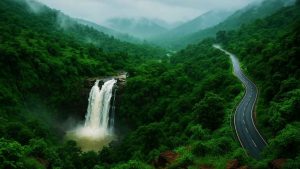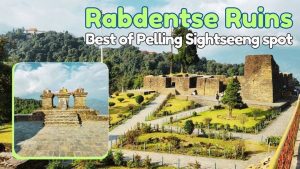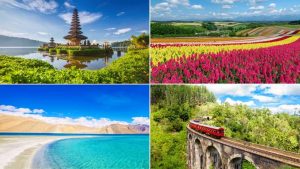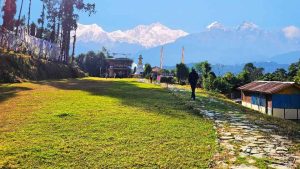Enveloped in absolute blue of the Bay of Bengal, Netaji Subhash Chandra Bose Island is one of the most beautiful and historically important islands in Andaman, formerly known as Ross Island. Once used as the capital of the Andaman territory, N.S.C Bose Island is now a standing showcase of the past reign of the British. Despite any permanent human habitat, this place is a safe haven for the wilds; deers, peacocks, seagulls, reptiles, and tons of marine species live happily on and around this island along with the ruins of the penal settlements.
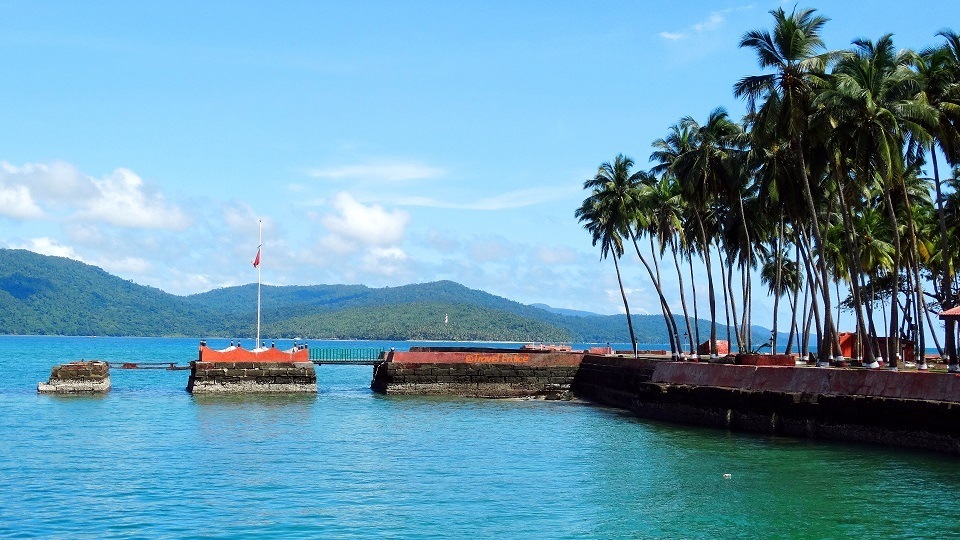
From the nomenclature to the untold epics, Netaji Subhash Chandra Bose Island is truly mysterious like the legendary freedom fighter of the nation, Netaji Subhash Chandra Bose. Nevertheless, the magnificent natural beauty of the Island, chances to meet the unafraid wilds, and the scope to witness the ruined history attract thousands of tourists to N.S.C. Bose Island (formerly Ross Island) every year.
I’m glad to share my personal touring experience to Netaji Subhash Chandra Bose Island, including the history, things to do, how to visit, where to stay, and more. I hope the following information and guidelines will help you to plan a perfect trip to N.S.C. Bose Island/ Ross Island during your Andaman tour.
Unknown History of Netaji Subhash Chandra Bose Island
N.S.C Bose Island witnessed a prolonged and memorable history full of painful stories. The Island was first occupied in 1782, but it was shortly abandoned due to unsustainable conditions. Decades later in 1858, during the British reign of East India, a penal settlement was established on the previously called Ross Island. About 200 Indian rebellions were transferred to Ross Island in that year from Calcutta (Kolkata).
The Fate of the Prisoners
The penal settlement was meant as the punishment for the prisoners (Indian Freedom fighters/rebellions and hard-core criminals) to stay far away from home on a remote island without any communication with the mainland. The prisoners had to clear off the dense forest of Ross Island for constructing all of the important offices, the Chief Commissioner’s bungalow, and other constructions for the British. They were forced to work overtime with minimal food, water, clothes, and shelter. At the end of the task, they were thrown into the dark cell of the jail on Viper Island, which was also constructed by the same prisoners (in fact, they were constructing the prison for themselves and the future prisoners).

Needless to say, the intolerable brutality of the British police forced many prisoners to plan escapes from the island, which was literally impossible. They often got re-arrested and sentenced to another set of brutal punishments or hanged to death. Prisoners who tried to swim across the sea were drowned in the deepest part of the sea (Kala-Pani) that devours everything.
It was reported that the prisoners of Ross Island, Viper Jail, and Cellular Jail were forcefully treated with different doses of quinine for experimentation on the effects of the medicine. As a result, they were mentally distorted and started to physically harm each other. Many prisoners died due to continuous physical and mental torture, insufficient food, shelter, treatment, snake bite, and many other unwanted reasons. According to the report, more than 70% of the prisoners were physically unfit.
A short Japanese era in Ross Island
The penal settlement was demolished by the Japanese when they occupied Ross Island in 1942 during Second World War. The Government House of the British Chief Commissioner became the residence of the Japanese admiral for three years (from March 1942 to October 1945).
Some of the constructions were abandoned after the earthquake in 1941, though any life hadn’t been threatened in that earthquake.
The rebellion prisoners were ultimately freed after the Independence of India (15 August 1947) and the Islands were handed over to the Government of India.
Related Article: Pondicherry – Explore Paradise Beach to Auroville
From Ross Island to Netaji Subhash Chandra Bose Island
The island was previously known as Ross Island, which was named after the surveyor Captain Daniel Ross. He was a hydrographer employed by the East Indian Company. He was known as “the father of the Indian surveys” regarding the scientific accuracy of his work. He landed on the small island in 1788 and surveyed it for a year. Eventually, he left the island due to unpredictable weather conditions, water scarcity, and the unavailability of living facilities.

On 30 December 2018, the island was renamed after the GREATEST Indian freedom fighter Netaji Subhash Chandra Bose. After the announcement of Prime Minister Narendra Modi as well as the declaration by the government of India, the island achieved its new name, “Netaji Subhash Chandra Bose Island”. During the Second World War II Netaji stayed there from 29th to 31st December 1943 with the Japanese (He collaborated with the Japanese for the freedom of India from the British regime).
If you are interested to know more about the nation’s “Real Hero” Netaji Subhash Chandra Bose, and if you want to know the real truths about him, you can follow Chandrachur Ghose and Anuj Dhar, and also read their books, which are written after years-long research on the Greatest freedom fighter of the nation.
Well, so far we have learned a lot of history about Netaji Subhash Chandra Bose Island. Now, let’s have some detailed discussion from the tourism viewpoint.
Things to Do in Netaji Subhash Chandra Bose Island
Situating close to Portblair, Netaji Subhash Chandra Bose Island occupies a little coverage area of only 0.312 square km (length 1.25 km and width 0.52 km), while the peripheral coastline is only 3.20 km long. You can walk across the whole island very easily and can explore the beauty and the historical monuments within the island in 2-3 hours. Nevertheless, these “only” 2-3 hours may be the most remembered moments of your entire Andaman trip, if you use these hours systematically.

On your Andaman trip, you’ll be exploring many beautiful beaches, Islands, vibrant blue shades of the sea, water sports, and underwater activities, but without experiencing the magnificence of NSC Bose island and exploring its prolonged history, your trip remains literally incomplete.
Below I’m highlighting the top 5 things to do in Netaji Subhash Chandra Bose Island (formerly Ross Island) that you shouldn’t skip under any circumstances.
- Explore the ruins, which will take you back to history.
- Visit the sanctuary to meet friendly animals living there.
- Visit the seashore and enjoy romantic hours with the rhythm of unstoppable sea waves and mindblowing sea breeze. If you are lucky, you can also find some dead fossilized coral shells or antlers of deer.
- Go through the man caves.
- Visit the pond and enjoy its serenity.
Now let’s elaborate, why should you do all these activities on this little Island!
Explore the ruins of Ross Island
The remnants of old buildings made by the prisoners during penal settlement are still standing there but in distorted conditions, most are partially engulfed by nature. Roots of ficus plants textured around the ruins, creating a photogenic view. The ruins include:
| Chief Commissioner’s residence | Man caves | The church |
| Swimming pool | Grand Ballrooms | Tennis court |
| Water treatment plant | Long strips of luxury gardens | Sanatorium |
| Printing press | Bunkers | Secretariat |
Note: I mentioned here “Ross Island” in the section heading because all those ruins happened when the name of the island wasn’t after the greatest freedom fighter of the nation, instead it was named Ross Island; now it is NSC Bose Island, and definitely a safe heaven for the tourists and the wild animals.
Now, let’s elaborate on some of the historical spots that I find most iconic.
Chief Commissioner’s residence
The Chief Commissioner’s house is the first bungalow on the island during penal settlement and is called the Government House. It was constructed at the northern summit of the island. Some of the Italian tiled flooring floorings are still visible there, though tumbled down due to lack of maintenance. During World War ll, this house became the residence of the Japanese admiral from March 1942 to October 1945.
Church, and other Recreational Constructions
Though the island is very small, the British army made all types of facilities for themselves. They abused the manpower of the prisoners to make church, swimming pool, grand ballrooms, tennis court, and other recreational constructions. The front and back walls of the church are still there.
Luxury Gardens
Long strips of fenced gardens were made along the roads. Some are still maintained by the caretaker for tourist attractions.
Printing Press
A small printing press is present in ruined condition. It was fully functional during the past times when mobile was not discovered.
Water Treatment Plant
The main source of drinking water in the Andaman Islands was rainwater. Rainwater was harvested and treated in the water treatment plant to make it drinkable. It could receive sufficient rainfall for 7 to 8 months; during the rainy season, they used to conserve water for the rest of the time to overcome the water scarcity.
Bunkers
The bunkers were made later on during World War II by the Japanese to put eyes on any foreign invaders coming through the sea. Today you can see large empty barrels, used to fulfill the purposes during World War II.
Sanatorium
The sanatorium was made during the first occupancy of the island in 1782. But after that, it was abandoned for years. Again it was reoccupied by the British during penal settlement. Also, they made a hospital for their treatment only (not for the prisoners).
Visit the Sanctuary
In the middle of the island, there is a well-protected sanctuary. The reserved area is filled with large old trees along with long coconut and palm trees. Sunlight traverses through them, making long beams of rays fall scattered on the ground. Deers and peacocks wander everywhere, welcoming you to their own land. Some of them even don’t learn to be afraid of mankind, which is absolutely wonderful; you can get closer to them, love them, and feed them.
A very special note for you, feeding the wilds packed food is strictly prohibited in NSC Bose Island, you can fairly feed them natural ones.
The deers like to eat the pulp of coconut; after I purchased coconuts from a sack, a couple of deers started following me until I put them down on the ground. I saw, they really enjoyed eating the pulp, so I purchased another two for them only.
The animals are taken care of by caretakers appointed by the Andaman Administration. Wilds are allowed to breed freely to increase the population. Also, several other birds chirp around throughout the whole NSC Bose Island.
You may like: Palolem Beach in Goa: Meet the ultimate spirit of Canacona
Visit the Seashore of Netaji Subhash Chandra Bose Island
As I mentioned above, the island is very small, and so is its coastal line. You can cover the whole are within 2-3 hours including reachable coastline. There are small beaches around the island; just find a shady one and enjoy your private time with the rhythm of waves and wind.
However, I must mention a particular little beach on Netaji Subhash Chandra Bose Island; most people skip this because the boatmen generally give 45-60 minutes of time to cover the island. Eventually, most people watch the ruins, take selfies with the wilds (deers and peacocks), and get back.
I suggest, don’t plan such an incomplete trip; rather contract the boatmen for a longer trip.
At the southern part of the island, there is an extremely serene beach, which you have to reach by crossing the stair steps and a deep forest across the island. Surrounded by the rows of palm and coconut trees and the deep blue sea, this beach offers genuine photogenic views and unforgettable memories. Indeed, it’s a perfect place to spend private hours with your loved ones.
During our NSC Bose Island trip, we spend there for 40 minutes and gathered some lifetime memories! Also, we could collect a very big dead Shell of specific Oyster species (approx. 1 sq. ft.) on this beach, but left it alone because collecting any dead shell is not allowed in Andaman.
Related: Kanyakumari Tourist Places
Go through the Man Caves
Man caves are interlinked tunnels, built across the Island to connect important offices. These were built to make it easy for the British officers to communicate between offices and other constructions in adverse weather conditions and also to escape during foreign attacks. Now the caves are abandoned but still showcase the efforts, skills, and hardships faced by the prisoners when they built those.
Some parts of the caves are still accessible, you can go through them; these are truly mysterious. It is recommended to take a guide along with you to swiftly come out if any problem arises.
Related: Chapora Fort in Goa – Explore the Hidden Heaven
Enjoy the Serenity of the Pond
There is a pond surrounded by the long coconut and palm trees in the forest. Rainwater is the main source of this sweet waterbody. Animals of the island often use it, though another source of drinking water is supplied to them for avoiding any sort of contamination. Also, the pond area is the home of some reptiles.
There is a sitting arrangement beside the pond. You can sit there to enjoy the greenery and serenity of the place with little caution (for the reptiles).
Foods in Netaji Subhash Chandra Bose Island
There is a Restaurant in Netaji Subhash Chandra Bose Island, namely Ross Treat restaurant. You can try light snacks, juice, or seafood there. If you are very hungry, they also offer you lunch, though we haven’t tried yet during our short trip to NSC Bose Island. Instead, we preferred drinking sweet coconut water from the peddlers.
On the whole Island, you can find 2-3 peddlers selling really tasty coconuts; if you are traveling to NSC Bose Island in a hotter season (Sep-Oct or March-April), it’s worth drinking plenty of coconut water.
How to reach Netaji Subhash Chandra Bose Island?
The island is about 4.8 km away from Port Blair and is clearly visible from the Rajiv Gandhi water sports complex. The Island is not connected with the mainland by any bridge, so there is no way to reach NSC Bose Island by road. You can reach there only by water vehicle. You can prebook a boat or ferry from the Water Sports Complex to ensure a hassle-free journey and save your time. Also, you can book your ticket online.
It takes less than 15 minutes to reach there by speedboat; the journey through the blue water is really exciting!
You need some entry fees for traveling through NSC Bose Island. Entry costs for adults and children are INR 90 and INR 25, respectively. Also, must carry your Identity card and/or passport (if foreigner).
You may like: Magnificent Kalacha Beach in Goa
How to plan a trip to Netaji Subhash Chandra Bose Island
You can easily plan a trip to NSC Bose Island by yourself by prebooking the ferry service from Water Sports Complex or online. If you are traveling to Andaman with a tour operator, they’ll arrange for you.
It is sufficient to spend half a day to cover the whole island. In another half, you may visit the North Bay Island, which is famous for water sports like snorkeling, scuba diving, sea walking, and shopping ornamental things made with natural marine creatures. You can find several ferries that offer combined trips to both of the islands together. Netaji Subhash Chandra Island remains open for tourists from 9:00 am to 4:00 pm, though the time may vary depending upon the weather.
Suggestion for you: carry some water and food while visiting the Island, because there are no sufficient food stalls. The only restaurant is a bit expensive.
When to visit Netaji Subhash Chandra Bose Island

It is good to avoid the rainy season and peak summer months (May-July) for planning an Andaman trip. The best season to visit the Andaman Islands is from November to February. You can also visit there in the months of October and March, though both of these remain a bit hotter compared to the peak season (November-February).
If there are any rough weather forecasts (storms or else), water sports as well as inter-island transport remain restricted and strictly prohibited.
Where to Stay near Netaji Subhash Chandra Bose Island
There is no hotel/resort on Netaji Subhash Chandra Bose Island; you have to stay in Port Blair for accessing this beautiful place. Port Blair city is rich with plenty of low-cost as well as luxury hotels.
Many tourists book Andaman trip from local tour operators, who arrange their selected hotels for you. So, in that case, you don’t have any choice.
In case, you plan an Andaman trip by yourself, you can choose hotels based on your budget. You may face difficulties in figuring out the best hotels in Port Blair. With the aim to solve this general problem, our team is presently reviewing the Port Blair-based hotels and resorts.
A complete review article introducing the best hotels in Andaman is upcoming soon. Hope, this will help you immensely.
Wrapping up
Overall Netaji Subhash Chandra Bose Island is a great place to visit for every tourist across the nation as well as the entire world, especially for those who love to explore exclusive ocean beauty and rich history together. In this place, your inner heart can hear the whispering of past British reign while exploring the ruins, while your joyful mind will fairly enjoy the heavenly ocean beauty.
In NSC Bose Island, you can eyewitness Mother Nature’s recovery process after facing massive brutality by mankind. In the British era, this little Island partially lost its greenery due to clearing off the natural forest followed by building concrete garbage in the middle of the sea. Later. during Second World War the island tolerated countless numbers of bombings; the entire region was covered by the smell of black smoke. Still, nature turned back to clear off everything, building up the green earth! Nowadays, most of the destroyed buildings are completely taken over by the roots and vines of large peepal and other trees.
Overall, the little jewel of Adman Sea, the Netaji Subhash Chandra Bose Island is simply incredible! Just make a perfect tour plan to make it worthy.
If you have any queries, don’t hesitate to post your query in the comment box below. I’ll be happy to help you out. Also, social sharing will be highly appreciated, if you find this informative and helpful.
Happy Andaman Trip!
Ms. Subhra Das is a biology teacher in high school. Besides she is a passionate traveler, science writer, and nature lover.
As a teacher, she never restricts herself to the four walls of the classroom, rather she loves exploring the crude science behind the natural facts that include human and animal health, critical diseases, typical characteristics of wildlife, and mother nature.
Ms. Subhra Das is also a passionate traveler and explorer; she always tries to uncover natural flora and fauna at every destination she travels.


